
B. How Flippers Work
C. Serial Coils
D. Parallel Coils
E. Computer Controlled Flippers
Solid State Flippers
Note: The following was written to describe how flippers work in early Bally SS pinball machines. But what follows is largely true for all pinball machines, including EM up through about the late 1980’s.
The following article was originally posted on Steve Kulpa’s Bally Page at stevekulpa.net.
Reproduced with permission from Steve Kulpa.
Written by Steve Kulpa
How Pinball Flippers Work – Early Bally SS
Many people are confused on just how flippers work with the double coils and switches and such. The flippers on the Bally early solid state machines are pretty straight forward, and fairly easy to understand, so I’ll take a stab at explaining them to you with enough detail so you’ll learn how they work, and how they’re wired up. Then hopefully the next time you have flipper trouble, you’ll know enough to properly diagnose the problem and fix them yourself!
First off, take a look here if you know nothing about coils, and I’ll show you how the solenoid coils in your Bally work, in general.
Next, a short blurb about Ohm’s Law: The flipper coils work off 43 Volts DC (VDC). According to Ohm’s Law, a small resistance draws a large current, and a large resistance draws a small current. This also implies that current flow will always try to follow the path of least resistance (like everything else in nature). Finally, for this example, just assume that current flows from positive to negative (ground).
If you look at a Bally flipper coil, you’ll notice 3 lugs instead of two, like in the picture below:

There are two coils in this assembly, a high power and a low power, joined together by the middle lug. Across the lower power coil is a switch, called the End Of Stroke (EOS) switch. Power (+43VDC) is applied to the single end of the high power coil and the single end of the low power coil is connected to the switch activated by the flipper button. The other side of the flipper button switch is connected to ground. So when you press the flipper button, a complete circuit to ground is established and the flipper coils are energized. Note that between the flipper button switch and the flipper coil is the Flipper Enable Relay. For simplicity’s sake, I’ve not shown this relay in most of my drawings on this page. Just keep in mind that it does exist.
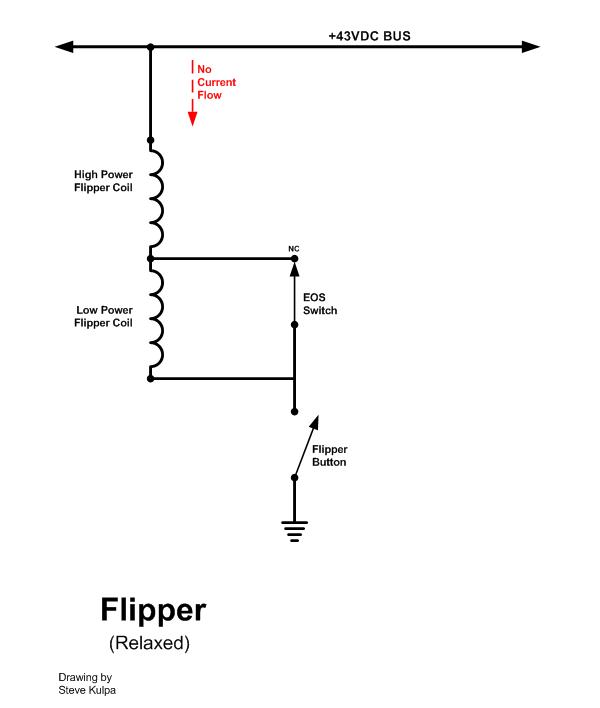
The picture above is a simplified schematic of a single flipper as used in the Bally early solid state machines. The high power coil has a small amount of wire (500 wraps), which results in a small resistance, around 10 ohms. Using Ohm’s law, at 43 volts, 10 ohms will draw about 4.3 Amps, which is quite a bit of current. The low power coil has over 5000 wraps of wire, resulting in about 350 ohms. At 43 volts, this coil will draw about .12 Amps, or 120 milliamps, which is a whole lot less than the high power coil. When you first press the flipper button, the path to ground is complete and power is applied to the high power coil. The EOS switch is used to bypass the lower power coil, at least for now. With only the high power coil being used, you get a nice strong flip. If you want to hold the flipper in the up position to trap the ball, the high power could would eventually burn up, or you’d blow a fuse. A continuous draw of over 4 Amps is just too much. To keep this from happening, as the flipper reaches the top of the flip, a little tab on the flipper pawl will activate the EOS switch. In the two pictures below, you can see a before and after photo of this phenomenon (look at the black tab thing that pushes the switch):
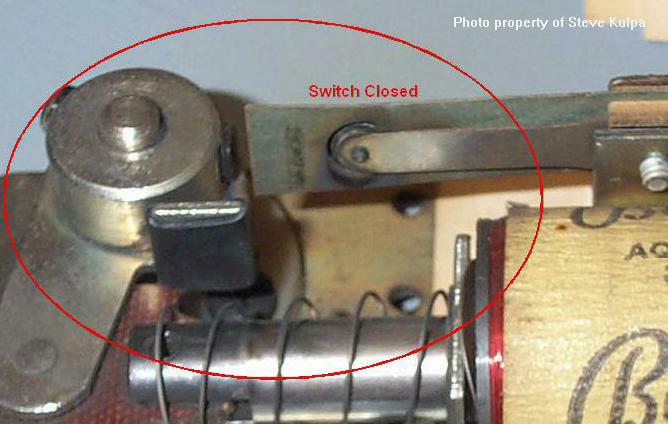
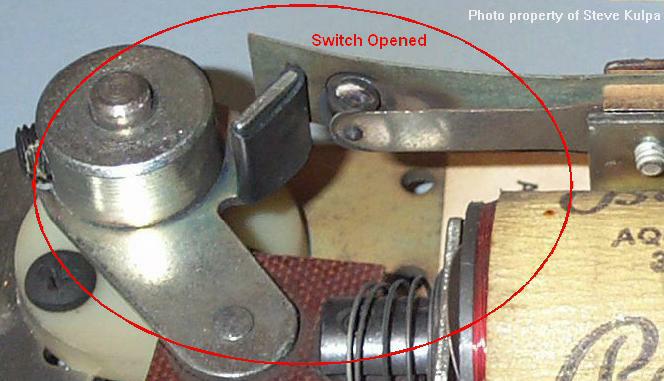
When the switch is normally closed, it basically puts a short across the low power coil and most of the current bypasses the lower power coil and flows through the switch (current takes the path of least resistance). So the majority of the current flows through just the high powered coil. This gives the flipper it’s punch. Then, when the flipper reaches its end of stroke, the tab opens up the switch which makes the current flow through the low power coil IN ADDITION to the high power coil. This adds lots more resistance, which drops the current flow, which allows the player to keep the flipper engaged in the up position without burning anything up. When the flipper button is released, the path to ground is lost, so the current no longer flows, the flipper coil relaxes allowing the flipper’s spring to return the flipper to it’s down position. The switch again closes and everything’s back to normal.
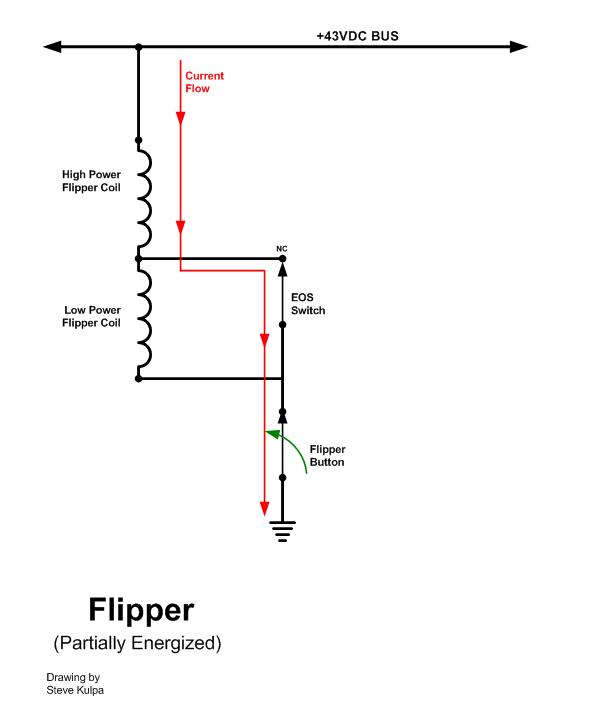
The picture above is what’s happening just as the flipper button is pushed. Current flows through high powered coil, but the EOS switch is closed so the current flow bypasses the lower powered coil. The high powered coil has a very low resistance, so it draws a lot of current, making for a nice strong flip.
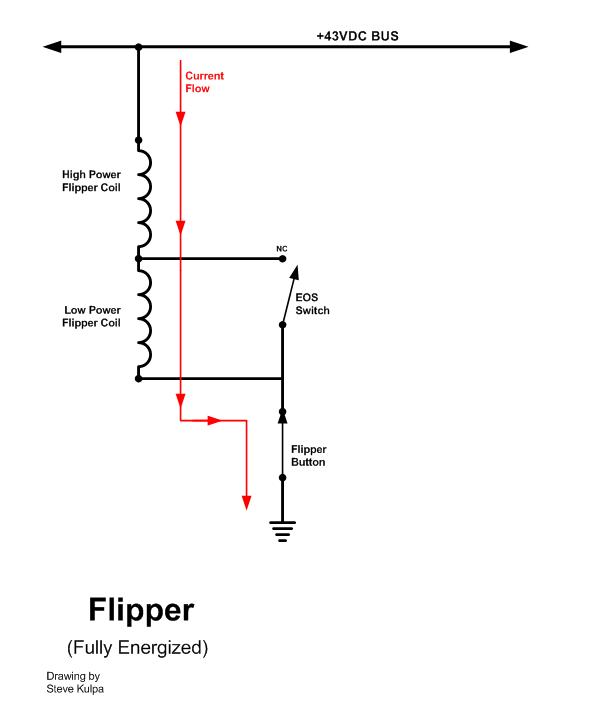
In this second picture, the flipper pawl has hit the EOS switch and it opens, allowing current to flow through both coils as long as the flipper is in the up positin. By switching in the low power coil, it’s resistance is added to the resistance of the high power coil and now the total resistance draws a lot less current. Enough to hold the flipper up, but not enough to burn anything up, or blow a fuse.
3- and 4-Flipper Machines
Some Bally machines, like Power Play and Flash Gordon, have “upper” flippers. For machines like this, things are a little different. The lower flippers pretty much behave as above, but things change just a little bit for the upper flippers. The upper flippers have their own EOS switches, which perform the same function as the EOS switch on the lower flippers. The difference is in how the upper flippers are powered. On machines with upper flippers, the EOS switch on the lower flipper is a double throw switch – one side is normally closed (NC), like above, and the other side is normally opened (NO). It’s this 2nd switch that connects the upper flipper to ground.
When you push the flipper button, the lower flipper goes first because the path to ground for the upper flipper has not yet been established. When the lower flipper hits its EOS switch, just as I mentioned above, the low power coil is introduced as the NC contacts open. On a properly adjusted EOS switch, immediately after the NC contacts open, the NO contacts should close. When they do close, the upper flipper coil will have a path to ground and will energize. Just as with a single lower flipper, the upper flipper has its own EOS switch, which is normally closed. So only the high power coil is energized and the flipper will flip. Then the upper flipper activates the EOS switch, opens the contacts, and introduces the lower power coil to the circuit. This lowers the total resistance on the upper flipper (just as the EOS switch did for the lower flipper) allowing the player to keep the flipper in the up position for an extended amount of time.
Below, I’ve redrawn the second and third pictures above to illustrate a dual-flipper setup, plus added a fourth:
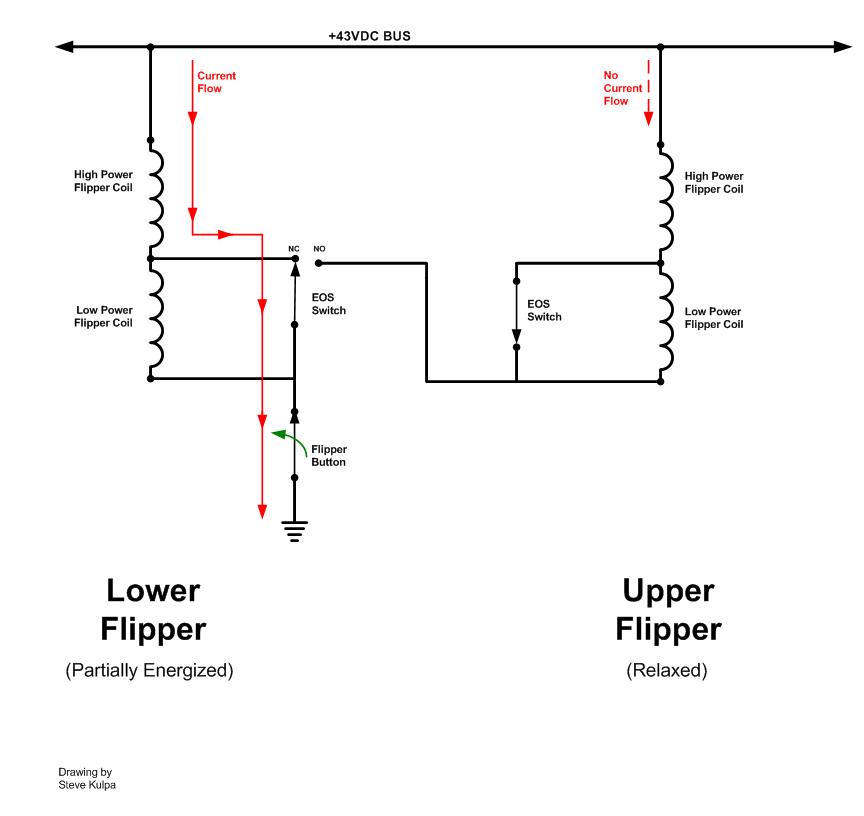
The picture above shows what’s happening just as the flipper button is pushed. Notice the 2-throw EOS switch on the lower flipper, and see how it is not yet supplying a path to ground for the upper flipper. As before, all the current is flowing through the lower flipper’s high powered coil only.

A fraction of a second later, the picture above shows the lower flipper’s EOS has opened which will switch in the lower flipper’s low power coil, allowing the player to hold the flipper in the up position, if desired. At the same time the lower flipper’s EOS switch will close the normally open contact. When this happens, the upper flipper now has a path to ground and will energize. You can also see how the upper flipper’s EOS switch is closed, which will power the high power coil only.
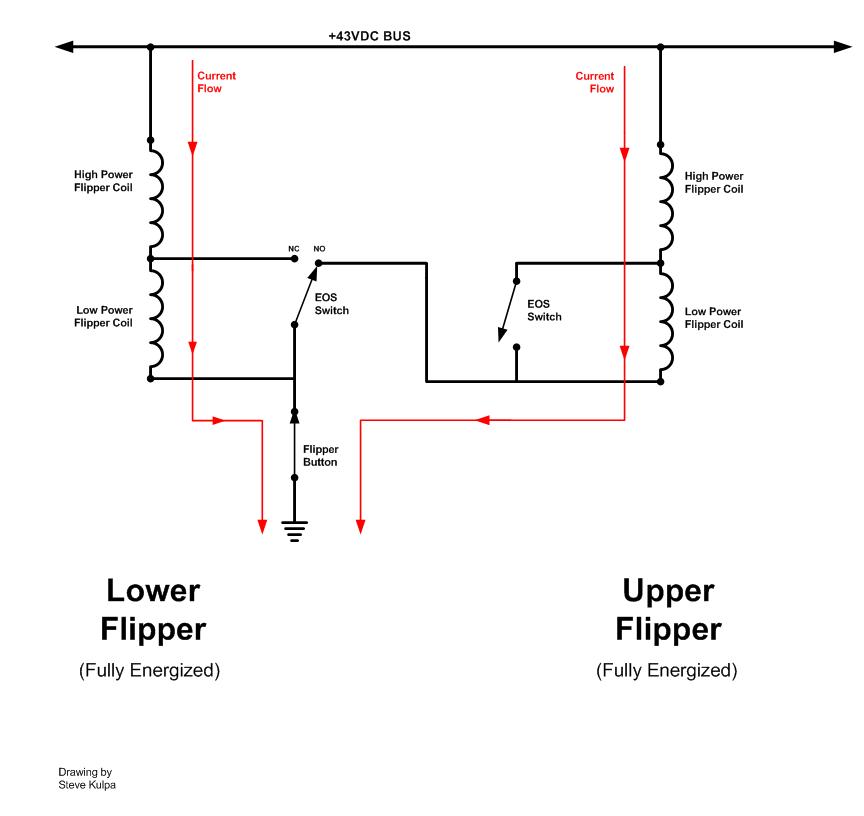
After another fraction of a second, the picture above shows the upper flipper’s EOS switch opening up, which switches in it’s lower power coil. Now both flippers are in the up position, and safely too as the lower power coils on both flippers have been switched in.
Flippers in Early Solid State Machines
[Note: this is not how EM flippers are controlled.
Now that you know how the flipper coils work, look at this drawing below:
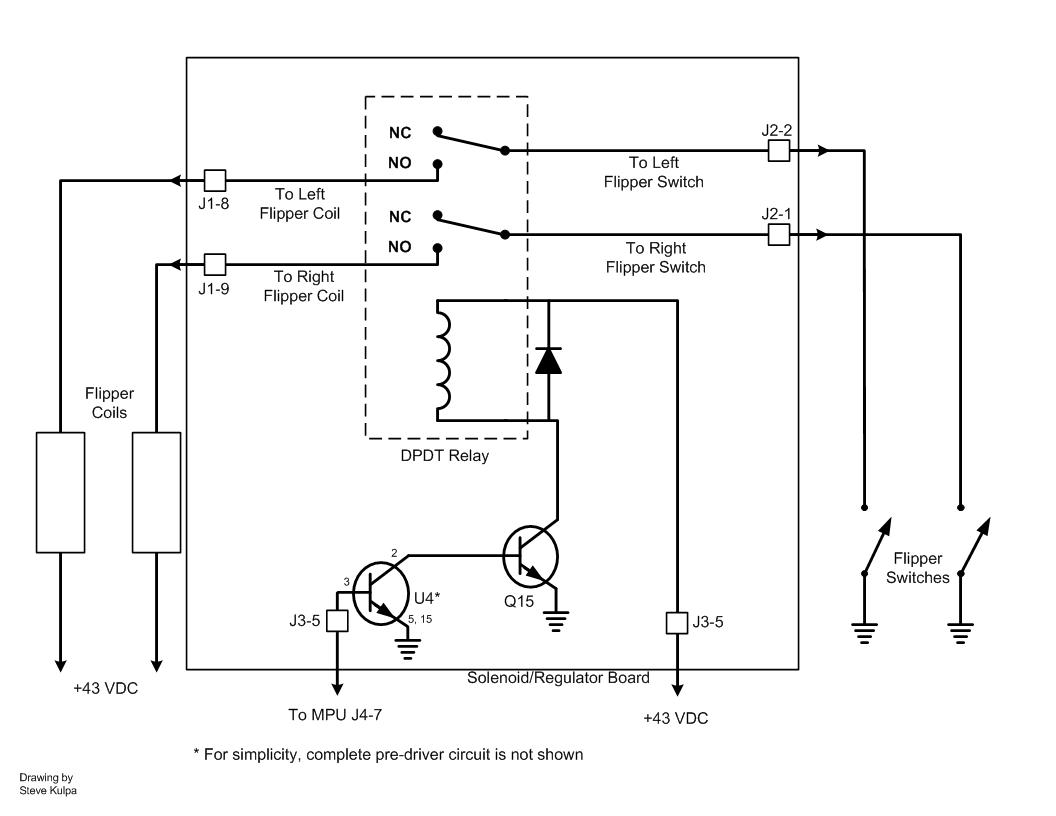
If you replace the boxes labeled “Flipper Coils” on the left with the pictures of the flipper coils and EOS switches from up above, you can see exactly how flippers work [in solid state machines]. The flipper enable relay is located on the Solenoid/Regulator board and is driven by the Q15 driver circuit. This is a “continuous solenoid” driver which is controlled by the MPU. When the relay is energized, the two switches inside the relay pull down and complete the circuit from the flipper buttons to the flipper coils. As long as the relay is energized, the flippers will respond to the buttons.
If all of your flippers do not work, you should check the Q15 driver circuit and make sure it’s OK. You can ground the tab on Q15 and that should make the relay pull in. While that DOES NOT test Q15, it does verify the circuit traces from Q15 to the relay are good, and that the relay itself is working properly. If the relay is working properly when you ground the tab of Q15, make sure the flipper relay pulls in during the solenoid diagnostic test. If it does pull in, then Q15 is OK. If not, replace Q15. If the relay is working properly but your flippers are not, then you probably have a problem with the wiring, the flipper switches, or the coils and/or EOS switches.
On a rare occasion, the relay will fail and neither flipper will work. On an even rarer occasion, the switches inside the relay will fail and one or the other (or both) flippers will not work. You can usually hear the relay pull in at the end of the MPU boot process, just around the time you see the 6th flash on the MPU’s LED [in early Bally / Stern SS pinball machines].
Next: Parallel Coils